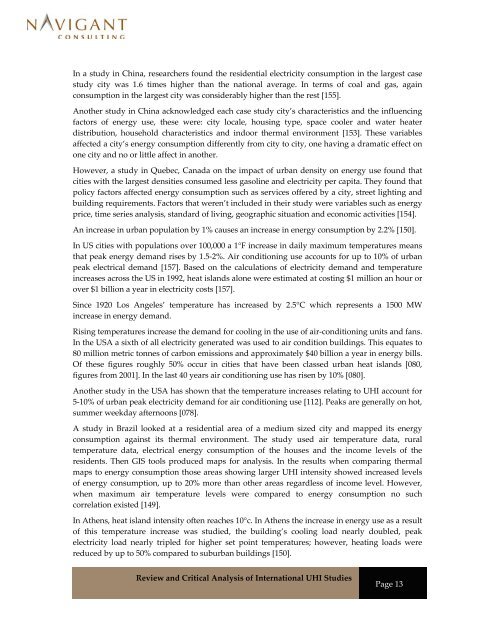Review and Critical Analysis of International UHI Studies
Review and Critical Analysis of International UHI Studies
Review and Critical Analysis of International UHI Studies
Create successful ePaper yourself
Turn your PDF publications into a flip-book with our unique Google optimized e-Paper software.
In a study in China, researchers found the residential electricity consumption in the largest case<br />
study city was 1.6 times higher than the national average. In terms <strong>of</strong> coal <strong>and</strong> gas, again<br />
consumption in the largest city was considerably higher than the rest [155].<br />
Another study in China acknowledged each case study city’s characteristics <strong>and</strong> the influencing<br />
factors <strong>of</strong> energy use, these were: city locale, housing type, space cooler <strong>and</strong> water heater<br />
distribution, household characteristics <strong>and</strong> indoor thermal environment [153]. These variables<br />
affected a city’s energy consumption differently from city to city, one having a dramatic effect on<br />
one city <strong>and</strong> no or little affect in another.<br />
However, a study in Quebec, Canada on the impact <strong>of</strong> urban density on energy use found that<br />
cities with the largest densities consumed less gasoline <strong>and</strong> electricity per capita. They found that<br />
policy factors affected energy consumption such as services <strong>of</strong>fered by a city, street lighting <strong>and</strong><br />
building requirements. Factors that weren’t included in their study were variables such as energy<br />
price, time series analysis, st<strong>and</strong>ard <strong>of</strong> living, geographic situation <strong>and</strong> economic activities [154].<br />
An increase in urban population by 1% causes an increase in energy consumption by 2.2% [150].<br />
In US cities with populations over 100,000 a 1°F increase in daily maximum temperatures means<br />
that peak energy dem<strong>and</strong> rises by 1.5‐2%. Air conditioning use accounts for up to 10% <strong>of</strong> urban<br />
peak electrical dem<strong>and</strong> [157]. Based on the calculations <strong>of</strong> electricity dem<strong>and</strong> <strong>and</strong> temperature<br />
increases across the US in 1992, heat isl<strong>and</strong>s alone were estimated at costing $1 million an hour or<br />
over $1 billion a year in electricity costs [157].<br />
Since 1920 Los Angeles’ temperature has increased by 2.5°C which represents a 1500 MW<br />
increase in energy dem<strong>and</strong>.<br />
Rising temperatures increase the dem<strong>and</strong> for cooling in the use <strong>of</strong> air‐conditioning units <strong>and</strong> fans.<br />
In the USA a sixth <strong>of</strong> all electricity generated was used to air condition buildings. This equates to<br />
80 million metric tonnes <strong>of</strong> carbon emissions <strong>and</strong> approximately $40 billion a year in energy bills.<br />
Of these figures roughly 50% occur in cities that have been classed urban heat isl<strong>and</strong>s [080,<br />
figures from 2001]. In the last 40 years air conditioning use has risen by 10% [080].<br />
Another study in the USA has shown that the temperature increases relating to <strong>UHI</strong> account for<br />
5‐10% <strong>of</strong> urban peak electricity dem<strong>and</strong> for air conditioning use [112]. Peaks are generally on hot,<br />
summer weekday afternoons [078].<br />
A study in Brazil looked at a residential area <strong>of</strong> a medium sized city <strong>and</strong> mapped its energy<br />
consumption against its thermal environment. The study used air temperature data, rural<br />
temperature data, electrical energy consumption <strong>of</strong> the houses <strong>and</strong> the income levels <strong>of</strong> the<br />
residents. Then GIS tools produced maps for analysis. In the results when comparing thermal<br />
maps to energy consumption those areas showing larger <strong>UHI</strong> intensity showed increased levels<br />
<strong>of</strong> energy consumption, up to 20% more than other areas regardless <strong>of</strong> income level. However,<br />
when maximum air temperature levels were compared to energy consumption no such<br />
correlation existed [149].<br />
In Athens, heat isl<strong>and</strong> intensity <strong>of</strong>ten reaches 10°c. In Athens the increase in energy use as a result<br />
<strong>of</strong> this temperature increase was studied, the building’s cooling load nearly doubled, peak<br />
electricity load nearly tripled for higher set point temperatures; however, heating loads were<br />
reduced by up to 50% compared to suburban buildings [150].<br />
<strong>Review</strong> <strong>and</strong> <strong>Critical</strong> <strong>Analysis</strong> <strong>of</strong> <strong>International</strong> <strong>UHI</strong> <strong>Studies</strong><br />
Page 13


